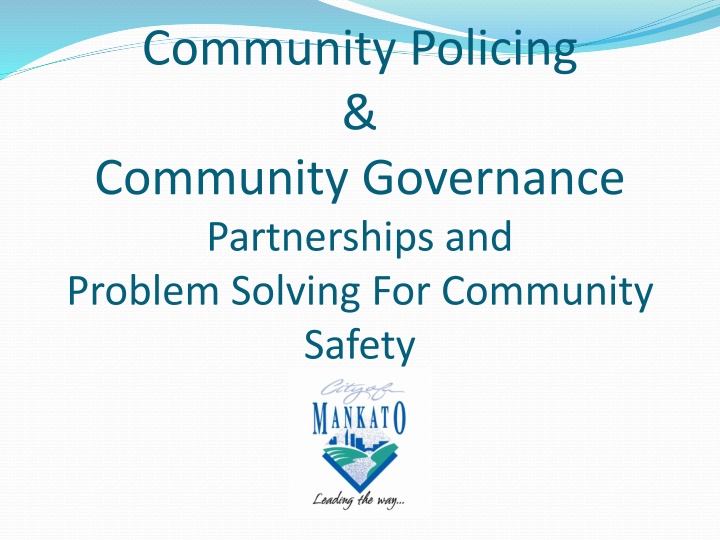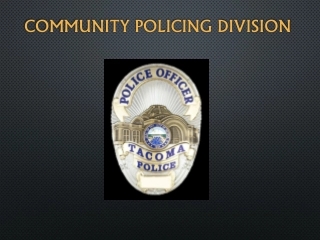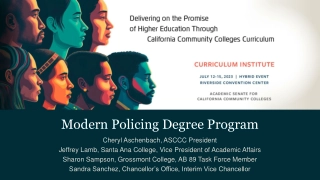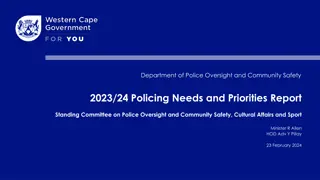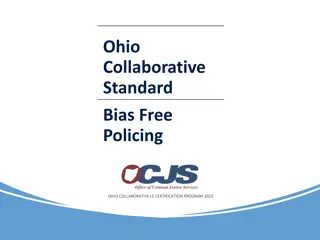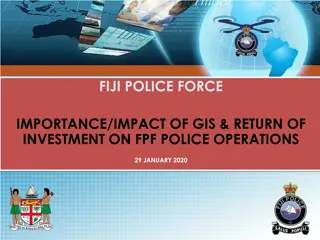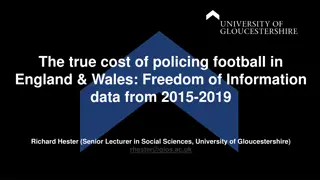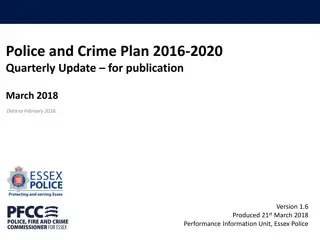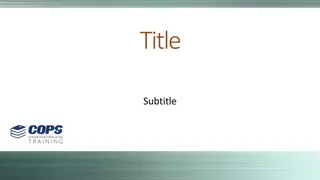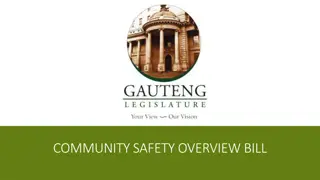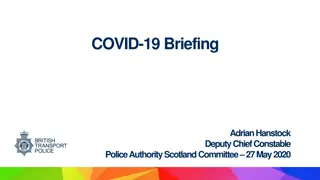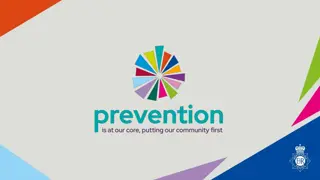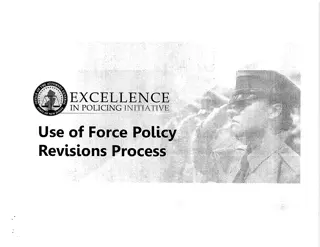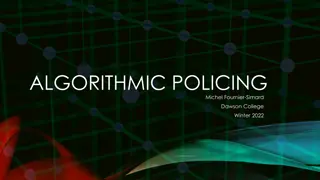Community Policing & Governance Partnerships for Safety
Chief of Police with extensive experience in community policing and governance, emphasizing shared responsibility for crime prevention, problem-solving, and enhancing quality of life. Advocating a shift from traditional policing to a community-oriented approach for more effective crime control and improved police services
Download Presentation

Please find below an Image/Link to download the presentation.
The content on the website is provided AS IS for your information and personal use only. It may not be sold, licensed, or shared on other websites without obtaining consent from the author.If you encounter any issues during the download, it is possible that the publisher has removed the file from their server.
You are allowed to download the files provided on this website for personal or commercial use, subject to the condition that they are used lawfully. All files are the property of their respective owners.
The content on the website is provided AS IS for your information and personal use only. It may not be sold, licensed, or shared on other websites without obtaining consent from the author.
E N D
Presentation Transcript
Community Policing & Community Governance Partnerships and Problem Solving For Community Safety
PROFESSIONAL EXPERIENCE Chief of Police Since 1976 4 States, 8 Departments Chair IACP Community Policing Committee 2006- 2014 Two Time Winner IACP & CISCO Community Policing Award 1999 and 2013 Instructor/Consultant/Speaker on Community Policing/Governance Issues Internationally Principal - POLICING LEADERSHIP GROUP, LLC - Building Bridges of Trust, Cooperation and Understanding Between Police, Government and the Communities They Serve
COMMUNITY RESPONSIBILITY Who s job is: Solving Crime? Preventing Crime? Maintaining or Enhancing Quality of Life? Shared Responsibility?
WHAT DID WE THE POLICE DO? For Years, we told the community to give us more money and more officers, and then to stand back and let us do our jobs. IT DIDN T WORK! By doing this, we took ownership of the crime problem
CRIME IS NOT A POLICE PROBLEM IT IS A COMMUNITY PROBLEM!
Traditional Policing Incident driven Reacting to individual events Invoking criminal justice process Using aggregate crime statistics to evaluate performance
Traditional Policing Strategies Preventative patrol Rapid response Follow-up investigations More Police Crackdowns
Based on Community Oriented Policing and Problem Solving
C.O.P. DEFINED Community policing is a policy and a strategy aimed at achieving more effective and efficient crime control, reduced fear of crime, improved quality of life, improved police services and police legitimacy, through a proactive reliance on community resources that seeks to change crime-causing conditions. It assumes a need for greater accountability of police, greater public share in decision-making, and greater concern for civil rights and liberties. Robert R Friedmann 1992
The Police are the Public, and the Public are the Police. are only those members of the Public who are paid to give full time attention to the duties that are incumbent on every citizen, in the interest of community safety. Sir Robert Peel The Police
Community Governance Core Components Building Community Partnerships as a Force Multiplier; Citizen and Govt. Agencies Problem Solving as a proactive strategy for reducing crime and disorder Organizational Transformation to support new strategies Community Outreach and Trust Building
COMMUNITY GOVERNANCE is a philosophical approach to local governance seeks to help cities better coordinate their service delivery and collaboratively solve community problems along with citizens and community based groups focuses on governance as a process rather than on government as an institution. relies on municipal agencies to engage each other and work together and with their community to address community problems, improve the quality of life, increase citizen satisfaction, and plan for the future.
WHY COMMUNITY GOVERNANCE? Each segment of local government has different resources, expertise, and perspectives that it can bring to respond to jurisdiction-wide issues. It is a matter of strategically coordinating these efforts, making them seamlessly experienced by the public, and developing more effective responses that add greater value to the public service being provided.
What C.O.G. Does Recognizes that the activities of one city department affect other departments. Provides a holistic approach to local government service delivery that breaks down organizational barriers. Encourages community and municipal stakeholders to pool expertise and limited resources to address community problems. Provides a voice for the full range of community stakeholders and input into decision-making processes.
What C.O.G. Does Engages community members in their own well-being and in improving the community s quality of life. Adheres to the democratic principles of equality and responsiveness. Increases the transparency and accountability of local government. Shares the responsibility for community safety and quality of life between local government and the community. Stresses community well-being outcomes (e.g., health and safety), rather than mere outputs (e.g., number of persons vaccinated, number of tickets written).
Problem Solving Problem Solving is best defined by its parts: 1. Identifying crime, disorder and fear problems. 2. Understanding the conditions that give rise to these problems. 3. Developing and implementing long- term solutions tailored to the problems. 4. Determining the solution s impact on the problems.
Problem Solving The SARA Model: Scanning - Group individual, related incidents as problems and define these problems in more precise and useful terms. Analysis - Information is collected from a variety of public and private sources, not just police data, to illuminate the underlying nature of the problem. Response - Work with citizens, businesses, public and private agencies, officers tailor a program of action that may go beyond traditional criminal justice remedies. Assessment - The impact of the response is determined to see if the problem was solved or alleviated.
Problem Solving Advantages Utilizes Officer Expertise and Creativity Greater Community Involvement/Resources Information Resources Expand Reduces Negative Labeling and Finger Pointing People Work Toward Mutual Goals Positive Roles for the People with the Problem Shares Ownership of the Problem Solutions are More Effective When Developed Together in Partnership
Community Partnership Community Partnership must include: 1. Positive relationships with the community. 2. Community involvement in the quest for better crime control and prevention. 3. Pooled approaches to address community members most urgent concerns. 4. Shared responsibility for finding workable solutions to problems that detract from community safety and security.
Community Partnership Four keys to the Community Partnership equation: 1. Community contact 2. Communication 3. Trust 4. Information exchange
Community Partnership Government Community Police Objective: To expand the area in which all three groups collaborate.
Benefits of Collaborative Partnerships Offers a comprehensive way to address a problem Increases coordination among public agencies and the community Represents the needs of all facets of the community Establishes a broad base of program support Viewed positively by funding sources Increases available information Fosters the feeling that we are not alone
ISSUES IMPACTING COPPS Agencies say they are doing community policing but they are not. One officer or one team isn t enough. Bike or foot patrol alone isn t COP Some say you need more Officers or more money to implement. You do not! It is a way of doing business. Crime stats may go up initially. In US, less than half the crime committed is actually reported. As you build trust with community, they will report more of actual crime. Should go back down.
ISSUES IMPACTING COPPS Current Training/Education Is Not Good Enough! All Officers Should Be Trained In Philosophy Higher Education Does Not Focus Enough On It P.O.S.T. Does Not Require It Agencies Don t Focus Enough On It In PTO Training Recently Lost A Great COP Resource In Minnesota
Award Winning Initiatives & Strategies in Community Policing
TAPESTRY PROJECT MANKATO MN Built on community policing philosophy of partnerships, problem solving, outreach Build trust through interaction Build strong community through education, mentorship, cross cultural communication Fully involved the refugee community as equal stakeholder
Tapestry Topics Health Health Services in America, Differences between Urgent Care and Emergency Room, Preventative Care Parenting Responsibilities, Discipline, Legal Requirements Government Services How Local Government Works, Transit and Transportation, Volunteering, Entrepreneurial Opportunities
Tapestry Topics Housing Landlord/Tenant Issues, Being a Good Neighbor, How to Use Washing Machines, Livability Issues, Bedbugs Safety Food Safety and Refrigeration, Cooking Fires, Crime Prevention, Law Enforcement and Ordinances/Laws in America
TAPESTRY PROJECT https://www.youtube.com/watch?v=q6Z39D-sU3E
SPEED ISSUES Minnesota Complaints of Speeding Vehicles and Dangerous Driving Speed Summit Neighbors Involved In Problem Identification Administrative Citations Education Over Enforcement Reduced Traffic Complaints by over 50%
BURGLARY Highland Village, Texas Operation Shield Business Burglary Problem Evaluation Found Burglars Entering Through Rear Doors with Inadequate Security Formed Partnership with Business and Volunteers Installed Latch Guards at Over 108 Businesses at No Cost to Business Community Stopped 100 Percent of This Type of Business Burglary
DRUG EDUCATION/AWARENESS Nassau County, New York Increasing # of Drug Overdoses and Deaths Prescription Narcotics and Heroin Youth in Community Were Victims Met with 56 Public School Districts Summit Brought Too Good For Drugs Curriculum to all Schools and Project Impact Video Trained Over 1000 Officers in Use of NARCAN Saved Over 20 Lives In First Month
HOSPITALITY SECTOR PARTNERSHIP Albuquerque, NM Partnership With Hotels/Motels Uses Crime Prevention/Awareness Training to Help Hotels To Be More Aware of Crime And Suspicious Behavior Occurring On Their Property Teaches How to Engage With Law Enforcement Theft, Drugs, Prostitution Utilizes Social Media Technology to Communicate Real Time Between Hotels and Police, and Between Hotels to Share Information
PERSONS IN MENTAL CRISIS Houston, Texas Police Responding to Over 23,000 Mental Health Crisis Calls Per Year, Many With Same People Partnership with Police, Mental Health Professionals and Health Department Identified Chronic Offenders and Provided Them Intensive Supervision 70% Decrease in Police Contacts, Less Mentally Ill in Jails, Less Visits to Hospital Emergency Rooms
ORGANIZED RETAIL CRIME Boise, Idaho Police Addressed Concerns With Organized Theft From Major Retailers Brought Together Major Retailers To Share Information Despite Differing Corporate Policies Educated Retailers on Emerging Trends Shared Real Time Information on Suspects Retailers Experienced a 41% Reduction in Loss to Fraud and Theft Compared to National Rates
REDUCING IMPACT OF TERRORISTS Andhra Pradesh Police, India Maoist Influence, Especially On Youth and Women In Attempt To Promote Overthrow Of Government Committed 18 Murders Police Led Goodwill March To Bring Services To Remote Villages Where Maoist s Operate Partnered with Government and Business to Bring Electricity, Water and Roads to Villages Employed 500 Youth, 150 Maoists Surrendered, 46 Villages Connected With Roads, 41 Villages With Water, 6 Villages With Electricity
YOUTH DETERRENCE & DEVELOPMENT Abington, Pennsylvania Youth Crime Was Skyrocketing Engaged Community Leaders, Neighborhood Groups, Community Organizations, Schools & Youth Focused on Diversion, Education, Youth Activities Reduced Part 1 Crimes by 30% Reduced Youth Arrests by 33% Reduced Fear of Crime by 40%
COMMUNICATION WITH CITIZENS Madison, Alabama Problem With Youth Fearing Police, Snitching, Afraid to Report Incidents Partnered to Create Text-to-Protect a Confidential Way To Share Information With Police Educated Students and Citizens On How To Use Received 1435 Texts on Students Contemplating Suicide, Bullying, Drugs, Assault, Theft, Weapons, and Threats of School Violence
SAFE NEIGHBORHOODS Evanston, Illinois Problems in a High Crime Housing Development Partnered with City Service Providers, Citizens, and Property Owners Utilized CPTED to Address Environmental Concerns Rebuilt Trust and Collaboration Between Citizens and Police, Reduced Fear Lowered Crime Rate In Area By 70%
Reducing Gang Violence & Influence Monrovia, California Experienced Gang Violence and Homicides Formative Years Project Where Police Worked With Parents & Children To Provide Life Skills & Education To Families With At-Risk Kids Classes Provided On Bullying, Media Influences, Internet Safety, Child Personal Safety, Gang & Drug Education and Prevention Trained High School Students to Mentor Younger Kids Successful In Keeping Kids Out of Gangs
Reintegration of Offenders Fort Myers, Florida Problem With Offenders Returning to Community From Prison Without Support Created COPE, Community Offender, Probation and Education Unit by Partnering with Service Providers Supports Offenders with Job Skills Training, Alcohol & Drug Counseling, Life Skills and Basic Education Provided Intensive Supervision To Recently Released Reduced Recidivism And Lowered Crime
Safe Summer Program Prince George s County, Maryland Crime Problem During Summer Nights Partnered With Recreation Department to Provide Late Night (8 PM to Midnight) Sporting Activities for Youth Ages 12-24 in 27 Locations In County Also Provided Specialized Workshops For Youth Each Locations had 1-2 Police Officers Participating 79% of Sites Saw Decrease In Crime Throughout Summer
Miami Shield Anti-Terrorism Miami, Florida Protects City s Tourism and Soft Targets By Educating Public on Anti-Terrorism Techniques and Vigilance Officers and Volunteers Saturate Tourist Areas to Educate Public - Hand Out Anti-Terrorism Brochures Identified 7 Signs of Terrorism to Educate Public Partnered with Businesses to Train Them on What Potential Terrorist Activities are and What To Watch For With Suspicious Activity
Hurst Intervention Team Hurst, Texas Community Experienced Citizens Living In Unsafe, Unsanitary and Sub-Standard Conditions Brought Together Police, Code Enforcement, Mental Health, Animal Control and Other Service Providers Passed Nuisance Ordinance Allowing Inspections Team Quickly Responds To Abate Sub-Standard Housing and Address Safety Concerns as well as Abuse Issues Saved Lives and Improved Community Health/Safety
Mall Theft Leesburg, Virginia Evidence Based Approach Found That 30% Of All Property Offenses Were Shoplifting Crimes One Location, A Mall, Was Responsible For 15% Of All Calls For Service, With 64% Being Shoplifting 70% Of Offenders Were Non-Local Partnered With Prosecutors, Academics, Local Businesses & Security Deterrence, Detection and Enforcement Approach Reduced Shoplifting by 31% in 6 Months
OUR CHALLENGE TO LAW ENFORCEMENT: If what you are doing does not have a positive impact or result; STOP doing it or do it differently NOW! 49
THANK YOU Todd A. Miller Cell: 507-340-2804 Cell: 214-616-1230 tmiller@mankatomn.gov chieftam@gmail.com
